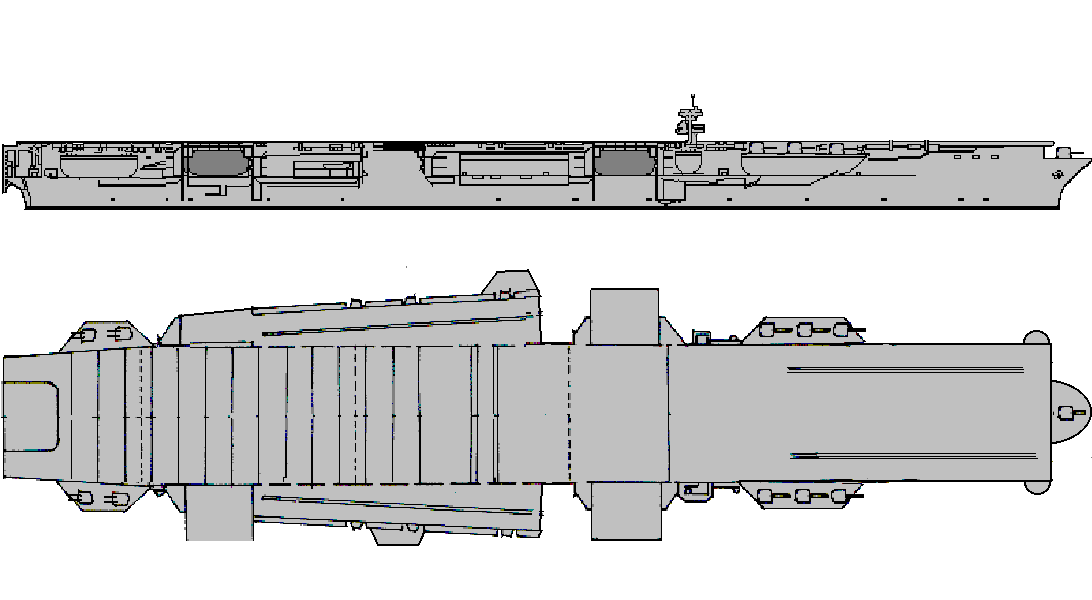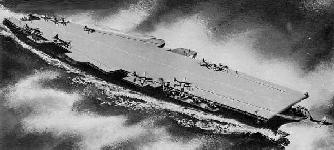



CVA 58 United States
After several years of planning, on 29 July 1948 President Truman approved construction of a "supercarrier", for which funds had been provided in the Naval Appropriations Act 1949. This first postwar carrier was laid down in April 1949. The flush-deck 65,000-ton CVA 58 United States was designed to launch and recover the large aircraft of 100,000 pounds required to carry early nuclear weapons, which weighed as much as five tons. The ship was to be over 1000
feet long, without an island, and of a radical new design. The construction cost of the new ship was estimated at $190 million, with the additional thirty-nine ships required to complete the accompanying task force estimated to cost $1.265 billion. The United States was also intended to provide tactical air support for air and amphibious forces and to conduct sea control operations. But the general perception was that the United States was primarily intended as a platform for long-range nuclear bombardment.
The Air Force viewed the United States as the embodiment of the Navy's nuclear aspirations as an attempt to challenge what had been an effective Air Force monopoly on strategic nuclear weapons delivery. A majority of the JCS maintained that the super carrier�s main
function would be a duplication of the primary role of the Air Force. In the face of limited budgetary resources, and responding to opposition from the Army and Air Force, Defense Secretary Louis Johnson announced on 23 April 1949 the cancellation of construction of the United States. This prompted the immediate resignation of Navy Secretary John Sullivan.
This marked the beginning of a major onslaught on Navy funding. The fiscal constraints placed on the military in the late 1940�s were severe, and plans debated in the summer of 1949 for the Fiscal Year 1951 budget called for deep cuts in naval aviation. Operational Essex Class carriers were to be reduced from eight to four, Carrier Air Wings from fourteen to six, operational Saipan Class carriers from ten to eight, Marine Squadrons from twenty three to twelve, Anti Submarine Warfare Squadrons from eight to seven, and Patrol Squadrons from thirty to twenty. While the Navy was struggling to maintain its carrier fleet, the Air Force was pushing for a seventy-group bomber force.
The famous "Revolt of the Admirals" cost Admiral Denfield his position as CNO, but it saved carrier-based naval aviation. The first atomic bombs went to sea on the USS Franklin Roosevelt in 1950. The Navy�s inability to convey carrier doctrine to policy makers negatively effect America�s preparedness for subsequent wars and conflicts of a limited nature. It would take the accumulated experience of numerous limited engagements, and more particularly, the Vietnam War, for defense planners to recognize anything approaching the full potential of the carrier.
Specifications
|
|
Displacement | 75,900 to 79,300 tons full load
|
|
Length | 1,090
|
|
Beam | 130 feet
|
|
Flight Deck Width | 190 feet
|
|
Speed | 33 knots
|
|
Power Plant | Eight boilers
four geared steam turbines
four shafts
280,000 shaft horsepower
|
|
Aircraft | 12 VA [89,000 lb 2,000-nm radius bombers]
45 XF2H Banshee fighers
|
|
Armament | 8 5-inch/54 guns
6 3-inch/37 guns
|
|
Complement | 3,019 ship's company
2,480 in air wing
|
|
|
Ships
|
| Name |
Number |
Builder |
Homeport |
Ordered |
Commissioned |
Cancelled |
| United States | CVA 58 | Newport News
| | 18 Apr 1949 | -- | 23 Apr 1949 |


Sources and Resources
http://www.fas.org/man/dod-101/sys/ship/cva-58.htm
Maintained by Robert Sherman
Originally created by John Pike
Updated Monday, January 03, 2000 3:59:09 PM







